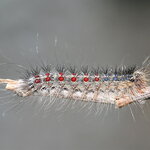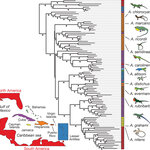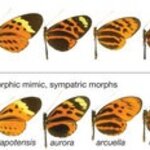Genetics & Molecular Biology

A genome-based immunization strategy may 'illuminate' ways to combat AIDS and other diseases.
Feline immunodeficiency virus (FIV) causes AIDS in cats as the human immunodeficiency virus (HIV) does in people, by depleting the body's infection-fighting T-cells. The feline and human versions of key proteins that potently defend mammals against virus invasion, termed restriction factors, are ineffective against FIV and HIV respectively. A Mayo Clinic team along with collaborators in Japan write in Nature Methods of their efforts to mimic the way evolution normally gives rise over vast time…

Some viruses change the behavior of their host, notable examples being the zombie ants and cat-loving rodents. Another example of such a ‘mind-controlling’ virus is the baculovirus, controlling its host, the gypsy moth caterpillar. A new study has identified a single gene that enforces this control on its host.
Healthy, uninfected gypsy moths (see figure 1) usually stay close to the ground, hiding from birds and other predators. Feeding happens at night. Infected caterpillars climb to treetops in broad daylight. But that’s not all the virus does. It forces the caterpillar’s cells to make…

Jumping genes, or more technically, transposons (see figure 1), are sequences of DNA that can move around the genome and find themselves a new place. In eukaryotic DNA, these jumping genes can constitute a sizeable portion of the genome (up to 50% of the human genome is made up out of active transposons and the remains of former ones that became inactive).
Figure 1: General structure of a transposon.
(Source: Scitable, by Nature Education)
Beyond being a mystery in themselves, these bits of moving DNA (and their remnants) are remarkably prevalent in chromosome…

Feel lazy? Maybe you can blame your genes.
Specially-bred mice which had two genes removed, which control the protein AMP-activated protein kinase (AMPK), an enzyme that is switched on when you exercise, didn't want to run a ny more.
"Mice love to run," said Gregory Steinberg, associate professor of medicine in the Michael G. DeGroote School of Medicine at McMaster University. "While the normal mice could run for miles, those without the genes in their muscle could only run the same distance as down the hall and back. It was remarkable. The mice looked identical to their brothers…

Bias in science academia is a big topic, but it's selective. If there are fewer women, it is regarded as a hostile environment but if there are no Republicans that is their choice.
Penn State researchers have added something new into the mix - hormones. If you are a woman who wanted to be a physicist, you may have been fighting your own sex hormones to do it, they say. They did it by looking at people's interest in occupations that exhibit sex differences in the general population and are relevant to science, technology, engineering and mathematics (STEM) careers…

As the genome sequencing technologies progress, and the costs per genome sequenced go down, the number of genomes sequenced increases. So far, several hundreds of genomes have been sequenced, with many more on their way. Now, the first lizard genome has been sequenced. The genome of the green anole (Anolis carolinensis) is the first non-bird reptile genome sequenced, and, as such, an important ‘gap’ in the vertebrate genome record is beginning to be filled.
Already, some interesting observations have been made.
Firstly, anoles appear to have a lot of transposable elements (stretches of DNA…

Increasing resistance of pathogens to antibiotics is an important issue. The hunt for new antibiotics/antimicrobials is on. For example, the 10X’20 Initiative aims to develop 10 new antimicrobial drugs by 2020. But where will these new drugs come from?
The recent efforts in sequencing marsupial genomes might prove helpful. Since the young of marsupials and monotremes are relatively little developed at birth, and have to survive outside of the sterile environment of the uterus, their immune system has to be capable of dealing with potential pathogens in their environment.
A new study,…

Cardiovascular diseases (CVD) already account for one third of all global deaths and raising, with effective heart regeneration therapies yet to be developed despite worldwide research efforts. But a new study by scientists from Oxford University and the University of Coimbra in Portugal might have put us a step closer with the discovery of the key molecule regulating the development of several heart and blood vessels’ tissues in the zebrafish embryo.
The molecule, called Fibroblast growth factor (FGF) works like a 'switch', inhibiting and activating the genes for different…

Why did adult human cardiac myocytes, specialized muscle cells in the heart, lose the ability found in newts and salamanders to proliferate, perhaps explaining why the human heart has little regenerative capacity?
A study using cell lines and mice may lead to methods of reprogramming a patient's own cardiac myocytes within the heart itself to create new muscle to repair damage, said Dr. Robb MacLellan, a researcher with the Eli and Edythe Broad Center of Regenerative Medicine and Stem Cell Research at UCLA and senior author of the study in Journal of Cell Biology.
While we…

Mimicry can often be observed in nature, and several types can be discerned. One of these types is known as Müllerian mimicry (named after the German zoologist Johann Friedrich Theodor Müller), or when two or more harmful species copy each other’s warning signals. This type of mimicry is well-known among unpalatable butterflies.
The question, however, is, how do they do this?
In the hope of elucidating the matter somewhat, researchers from the Centre Nationale de la Reserche Scientifique (at the National History Museum in Paris), and the University of Exeter, have set out to study the…